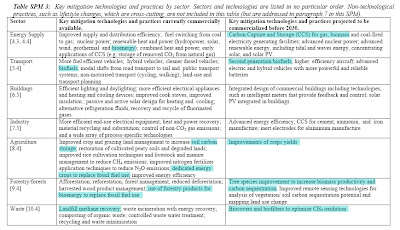IPCC 4th Assessment: Steps to mitigate climate change
 It is extremely difficult to develop objective assessments of the dangers of climate change. It is clear that millennia of mankind's attempts to manage Earth's resources to provide heat, shelter, and energy took a significant detour at the Industrial Revolution which started over a 150 years ago. With the introduction of faster transportation and communications, labor-saving devices, and centralized manufacturing based on fossil fuels, a dangerous atmospheric imbalance of greenhouse gases has resulted - one that threatens to change worldwide climate patterns.
It is extremely difficult to develop objective assessments of the dangers of climate change. It is clear that millennia of mankind's attempts to manage Earth's resources to provide heat, shelter, and energy took a significant detour at the Industrial Revolution which started over a 150 years ago. With the introduction of faster transportation and communications, labor-saving devices, and centralized manufacturing based on fossil fuels, a dangerous atmospheric imbalance of greenhouse gases has resulted - one that threatens to change worldwide climate patterns.
The jury is still out on when and how fast climate change will happen. However, it is universally agreed that, anticipating significant consequences from inaction, we need to begin remedial steps to mitigate climate change now.
In its fourth assessment the International Panel on Climate Change (Working Group III) has attempted to provide a series of steps to mitigate climate change by revising the management of current industrial, energy, transport, agricultural, forestry, architectural, and waste practices. It is a scientific analysis of what needs to be done - as a opposed to how the steps should be implemented (which has profound economic and political effects).
The consequences of inaction is stated in terms of degrees Celsius of average global temperature increase. While it is impossible to properly assess what the specific effect and repercussions would be for each degree of rising temperature, suffice it to say that the impact would be economically, socially, biologically, and politically profound.
BIOpact has prepared a lengthy summation of the report summary's major findings. Here are excerpts from their article:
----------------
IPCC Fourth Assessment Report: mitigation of climate change
BIOpact Blog
The report is a first draft entitled Summary for Policy Makers [*.pdf], and looks at five major issues:
• Greenhouse gas (GHG) emission trends
• Mitigation in the short and medium term, across different economic sectors (until 2030)
• Mitigation in the long-term (beyond 2030)
• Policies, measures and instruments to mitigate climate change
• Sustainable development and climate change mitigation The report presents mitigation options that can be implemented by relying on currently available technologies, and those that are expected to be available in the medium term (2030). Many of those technologies deal with biofuels, bioenergy and bioproducts, including the carbon negative energy system known as 'Bio-Energy with Carbon Storage' (BECS), to which we refer often. This last option can be seen as a 'geo-engineering' option, because it involves large-scale energy plantations. The Summary sees BECS as a suitable strategy to reach the reductions presented in several mitigation scenarios, because the negative emissions system cleans up the carbon emissions from the past.
The report presents mitigation options that can be implemented by relying on currently available technologies, and those that are expected to be available in the medium term (2030). Many of those technologies deal with biofuels, bioenergy and bioproducts, including the carbon negative energy system known as 'Bio-Energy with Carbon Storage' (BECS), to which we refer often. This last option can be seen as a 'geo-engineering' option, because it involves large-scale energy plantations. The Summary sees BECS as a suitable strategy to reach the reductions presented in several mitigation scenarios, because the negative emissions system cleans up the carbon emissions from the past.
The broad conclusion that can be drawn from the report is that the world has both the knowledge, technologies and financial means to avoid the worst effects of climate change (as they were outlined by Working Group II, earlier post), by investing in renewables such as biofuels and in nuclear, by improving energy efficiency, by limiting the use of fossil fuels, by increasing the efficiency of agriculture and by investing in carbon capture and storage, including BECS [the carbon negative energy system known as Bio-Energy with Carbon Storage (BECS)]. A portfolio of those options makes it possible to limit emissions in such a way that global temperature increase does not surpass the 2°C mark. The technologies are available, but political will and a change in life-styles by wealthy consumers will be required.
technorati BIOconversion, bioenergy, biofuels, legislation, greenhouse, decentralization, security



No comments:
Post a Comment